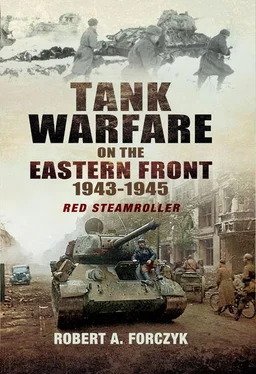However, only 30 per cent of the Red Army’s armour was deployed in large-scale tank and mechanized corps, while the rest was still employed in smaller units geared toward the infantry support role. The Narodnyi Kommisariat Oborony (NKO or People’s Commissariat of Defence), which directed organizational changes, was acting to change this imbalance by gradually phasing out many of the OTBs and consolidating more brigades within corps-size structures, but this would not be fully realized until 1944. Thus, the maintenance of so many smaller tank units tended to make it difficult for the Soviet fronts to mass decisive combat power and to maintain it through a protracted battle of attrition. Brigade size and smaller tank units could be consumed in a single action, which often caused Soviet offensive pulses to lose momentum at critical moments.
At the start of 1943, the Red Army’s tank units relied primarily upon the T-34/76 medium tank (known to Soviet tankers as the Tridtsat’chetverka ), which had the excellent V-2 diesel engine, sloped armour and the decent 76.2mm F-34 gun. Yet while the T-34 had been an impressive weapon in 1941–42, it had seen only modest evolutionary improvement during the first two years of the war due to the NKO’s desire to achieve maximum production, rather than tinker with the design. The basic ammunition load, typically 75 OF-350 HE-Frag rounds and 25 BR-350A APHE rounds indicated that the T-34/76 was primarily intended to attack soft targets, not other tanks. A new hexagonal turret had been introduced in 1942, along with slightly thicker armoured protection, but there was no change in firepower and crew ergonomics – particularly for the commander – were suboptimal. The lack of a commander’s cupola, which German tanks had, seriously reduced the situational awareness of T-34 tank commanders. The T-34 did receive one upgrade in 1943 that made a real difference: more and better tactical radios. Stalin had not appreciated the value of the electronics industry, so it had a low priority in the pre-war Five Year Plans. Consequently, Soviet industry was not able to manufacture enough radios for each tank and during 1941–42 only platoon leaders and above received a radio in their tank. Furthermore, the NKO failed to evacuate pre-war electronics factories eastward in 1941, so Soviet domestic manufacture of tank radios fell off sharply in 1942. However, in 1943 the British began supplying radio components in large quantities to the Soviet Union, which was able to introduce an improved 9R radio for the T-34 and by late 1943, most Soviet tanks were equipped with a radio or at least a receiver. {40} Brigade and higher-level communications remained problematic throughout 1943, since the Tank Brigade command post was only provided with two 12-RP radio sets with a range of only 8km. {41}
The Red Army’s other two domestically-built tanks, the KV-1 heavy tank and the T-70 light tank, added little to overall armoured capabilities. Since the beginning of the war, the KV-1 heavy tank had failed to properly fulfill its role as a breakthrough tank due to persistent mobility issues with its inadequate transmission – it was unable to keep up with other Soviet tanks. In order to improve mobility, the KV-1S tank was introduced in December 1942, which was five tons lighter than previous models; this increased off-road speed from 13 to 24km/hour but at the cost of reducing armoured protection by 30 per cent. Consequently, the KV-1S was only marginally faster, but significantly more vulnerable. Recognizing that the KV-1 series was a technological dead-end, the NKO decided to relegate KV-1 tanks to separate heavy tank regiments and to cease production as soon as a better alternative was available. Finally, the ubiquitous T-70 light tank was in most Soviet tank units from battalion to corps as a filler, until more medium tanks were available. The NKO knew that the T-70 could not stand up to even the German Pz III series tanks, but there was little alternative. What the T-70 lacked in firepower and armoured protection, it made up for in sheer numbers.
Unlike the German Heer, the Red Army had failed to make a significant investment in halftracks, which negatively affected the mobility of the mechanized infantry units within tank formations and impaired their logistic support capabilities in mud and snow. There was no Soviet equivalent of the German Sd. Kfz. 250/251 type armoured personnel carriers and the limited number of U.S. M2 and M5 halftracks delivered under Lend-Lease were usually used as command vehicles or prime movers for artillery, not to transport infantry. Instead, the Red Army continued to rely upon tanks to transport a significant amount of infantry on their decks in the desant role. Soviet industry had developed the ZIS-22 halftrack (based upon the ZIS-5 truck) and the GAZ-60 halftrack in the mid-1930s, but only about 1,100 were built before the German invasion and most were lost in the first year of the war. In 1942, the ZIS-42 halftrack entered large-scale production, but this vehicle’s mobility in snow and mud was very poor. Consequently, the Red Army’s tank units were not provided with either the quantity or quality of German tracked support vehicles – an important but often ignored deficiency.
Soviet Tactical and Doctrinal Changes
On 16 October 1942, Stalin had issued Order No.325, which outlined a host of problems noted in the Red Army’s use of tanks in combat. Foremost was a lack of coordination between tanks and supporting infantry, artillery, engineers and aviation, which led to an inability to conduct the kind of combined arms warfare employed by German panzer units. A second significant problem was a failure of tank commanders to conduct proper reconnaissance or to use terrain properly; consequently, Soviet tank units had tended to ‘wander onto the battlefield’, unsure of where the enemy was located and ignorant of obstacles, including minefields. Finally, Soviet tank commanders at brigade and above often attempted to exercise Command and Control (C 2) over their units from fixed command posts and did not rely on radios, since they had few. Instead, Soviet tank commanders issued a rigid operations order with a very simplistic scheme of manoeuvre – usually a frontal attack – and expected subordinate battalions and brigades to fulfill it to the letter. This rigid Soviet tactical C 2style was the polar opposite of the German doctrine, which relied upon front-line leadership and flexibility through radio-coordinated operations. Consequently, Soviet tank units had been routinely bested by smaller German panzer units, due to their inherently rigid style of battle command. Although he made a fairly accurate assessment of shortfalls in Soviet armoured operations, Stalin failed to note that he was often responsible for causing many of these problems, by bullying commanders to prematurely start offensives and depriving them of time to coordinate with other units or to conduct proper reconnaissance. {42}
Order No.325 began the process of Red Army tankers learning from their mistakes and trying to close the gap in capabilities between them and their German opponents. The order stressed the importance of a well-planned artillery preparation and close-infantry tank coordination in the attack. Instead of tangling with German tanks – as had often happened in 1941–42 – Soviet tank corps were ordered to focus on destroying the enemy infantry, leaving artillery and anti-tank units to deal with German tanks. The order also stressed proper terrain reconnaissance and the use of surprise and deception ( maskirovka ) to catch the enemy off guard. Of course, it was easy for Stalin to dictate orders, but this standard became the doctrinal guidepost for the Red Army’s tankers heading into 1943.
One of the foremost tactical and doctrinal changes that the Red Army did begin to adopt in 1943 was the introduction of the Samokhodnaya Ustanovka (SUs or self-propelled guns), which were modelled on the German Sturmgeschütz. The Su-76, which mounted the reliable 76.2mm ZIS-3 anti-tank gun on a lengthened T-70 chassis, could be built in great quantity. The Su-122, mounting a 122mm howitzer on a T-34 chassis, offered Soviet mechanized infantry units a real boost in direct fire support. Altogether, the creation of regimental-size units equipped with SUs reflected a desire within the Red Army to hand off much of the infantry support mission to AFVs other than tanks. Although early technical problems slowed the introduction of the SU-equipped regiments in 1943, this step would gradually free more tanks to conduct offensive manoeuvre warfare rather than being tied to infantry units. Those tanks that remained in the infantry support role were increasingly assigned to the new separate tank regiments.
Читать дальше








![John Stieber - Against the Odds - Survival on the Russian Front 1944-1945 [2nd Edition]](/books/405234/john-stieber-against-the-odds-survival-on-the-russian-front-1944-1945-2nd-edition-thumb.webp)



